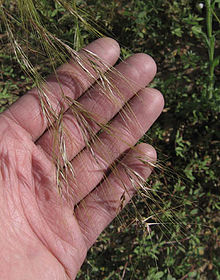
Stipa is a genus of around 300 large perennial hermaphroditic grasses collectively known as feather grass, needle grass, and spear grass. They are placed in the subfamily Pooideae and the tribe Stipeae, which also contains many species formerly assigned to Stipa, which have since been reclassified into new genera.
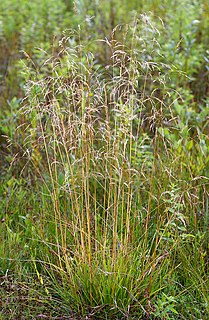
Deschampsia cespitosa, commonly known as tufted hairgrass or tussock grass, is a perennial tufted plant in the grass family Poaceae. Distribution of this species is widespread including the eastern and western coasts of North America, parts of South America, Eurasia and Australia.

Nassella, or needlegrass, is a New World genus of over 100 perennial bunchgrasses found from North America through South America. The Latin word nassa refers to "a basket with a narrow neck". It is usually considered segregate from the genus Stipa and includes many New World species formerly classified in that genus. As of 2011, The Jepson Manual includes Nassella within Stipa.

Aristida purpurea is a species of grass native to North America which is known by the common name purple three-awn.

Danthonia californica is a species of grass known by the common name California oatgrass. This plant is native to two separate regions of the Americas, western North America from California to Saskatchewan, and Chile.

Elymus glaucus is a species of grass known as blue wild rye or blue wildrye This grass is native to North America from Alaska to New York to northern Mexico. It is a common and widespread species of wild rye.

Festuca idahoensis is a species of grass known by the common names Idaho fescue and blue bunchgrass. It is native to western North America, where it is widespread and common. It can be found in many ecosystems, from shady forests to open plains grasslands.
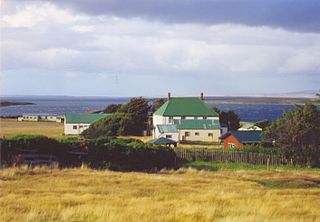
Tussock grasses or bunch grasses are a group of grass species in the family Poaceae. They usually grow as singular plants in clumps, tufts, hummocks, or bunches, rather than forming a sod or lawn, in meadows, grasslands, and prairies. As perennial plants, most species live more than one season. Tussock grasses are often found as forage in pastures and ornamental grasses in gardens.

Stipa coronata, formerly classified as Achnatherum coronatum, is a greenish species of grass known by the common name crested needlegrass, giant ricegrass, and giant stipa.

Achnatherum latiglume is a species of grass known by the common names wide-glumed needlegrass and Sierra needlegrass.

Achnatherum lettermanii is a species of grass known by the common name Letterman's needlegrass. The updated and accepted name is Stipa lettermanii. It is native to the western United States from California to Montana to New Mexico, where it is a resident of several types of habitat.

Stipa parishii, formerly classified as Achnatherum parishii, is a species of grass known by the common name Parish's needlegrass. The Jepson Manual 2nd edition (2012) reclassified the plant as Stipa parishii var. parishii.

Stipa speciosa (syn. Achnatherum speciosum is a species of grass known by the common name desert needlegrass. It is native to much of the south-western United States from California to Colorado, where it grows in dry areas, especially sagebrush habitat. It is also known from Mexico and parts of South America.

Calyptridium umbellatum, synonym Cistanthe umbellata, is a species of flowering plant in the montia family known by the common name Mount Hood pussypaws or — especially outside the Pacific Northwest — simply pussy-paws.

Sibaropsis is a monotypic genus of flowering plants in the family Brassicaceae containing the single species Sibaropsis hammittii, which is known by the common name Hammitt's clay-cress. It is endemic to California, where it is known from two locations in the Peninsular Ranges. The plant is known from the Santa Ana Mountains of Riverside County and Viejas Mountain and nearby peaks east of San Diego. It grows in grassy habitat in openings in chaparral alongside purple needlegrass, generally in moist areas in heavy clay soils. This species and its genus were first described to science in 1997.

Achnatherum thurberianum is a species of grass known by the common name Thurber's needlegrass. It is native to the western United States, where it occurs from Washington to California and east to Montana and Wyoming.
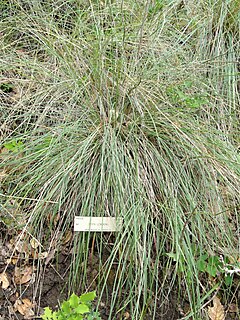
Stipa lemmonii is a species of grass known by the common name Lemmon's needlegrass. It is native to western North America, where its distribution extends from British Columbia to southern California.
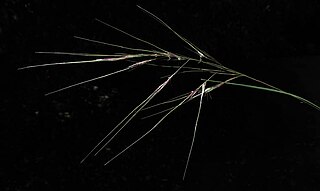
Nassella cernua is a species of grass known by the common name nodding needlegrass.

Nassella leucotricha is a species of grass known by the common names Texas wintergrass, Texas needlegrass, and Texas tussockgrass. It is native to the south-central United States and much of Mexico.
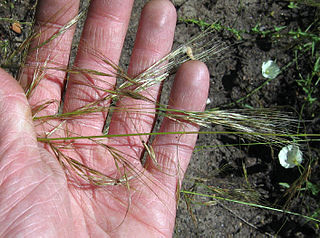
Nassella lepida is a species of grass known by the common names foothill needlegrass, foothills nassella, foothill stipa, small-flowered stipa, small-flowered needlegrass, and smallflower tussockgrass.
